
Concept explainers
The classification of soil based on United States department of agriculture textural classification chart.
Answer to Problem 5.1P
The classification of soil A as per the United States department of agriculture textural classification chart is
The classification of soil B as per the United States department of agriculture textural classification chart is
The classification of soil C as per the United States department of agriculture textural classification chart is
The classification of soil D as per the United States department of agriculture textural classification chart is
The classification of soil E as per the United States department of agriculture textural classification chart is
The classification of soil F as per the United States department of agriculture textural classification chart is
The classification of soil G as per the United States department of agriculture textural classification chart is
The classification of soil H as per the United States department of agriculture textural classification chart is
The classification of soil I as per the United States department of agriculture textural classification chart is
The classification of soil J as per the United States department of agriculture textural classification chart is
Explanation of Solution
Calculation:
Consider soil A:
Refer Figure (5.1) “U.S. Department of agriculture textural classification (USDA)”
in the text book.
Mark the percentage of sand for soil A as 20 %, percentage of silt as 20 %, and percentage of clay as 60 % in Figure (5.1) and mark the point of intersection of three lines.
Show the percentage of sand, silt, and clay of soil A as in Figure (1).
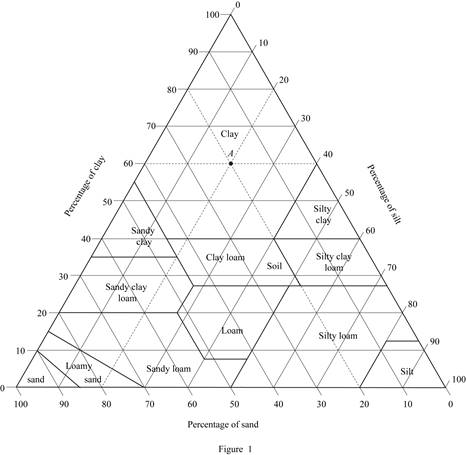
Refer Figure (1).
Hence, the classification of soil A as per the United States department of agriculture textural classification chart is
Consider soil B:
Mark the percentage of sand for soil B as 55 %, percentage of silt as 5 %, and percentage of clay as 40 % in Figure (5.1) and mark the point of intersection of three lines.
Show the percentage of sand, silt, and clay of soil B as in Figure (2).

Refer Figure (2).
Thus, classification of soil B as per the United States department of agriculture textural classification chart is
Consider soil C:
Mark the percentage of sand for soil C as 45 %, percentage of silt as 35 %, and percentage of clay as 20 % in Figure (5.1) and mark the point of intersection of three lines.
Show the percentage of sand, silt, and clay of soil C as in Figure (3).

Refer Figure (3).
The classification of soil C as per the United States department of agriculture textural classification chart is
Consider soil D:
Mark the percentage of sand for soil D as 50 %, percentage of silt as 15 %, and percentage of clay as 35 % in Figure (5.1) and mark the point of intersection of three lines.
Show the percentage of sand, silt, and clay of soil D as in Figure (4).
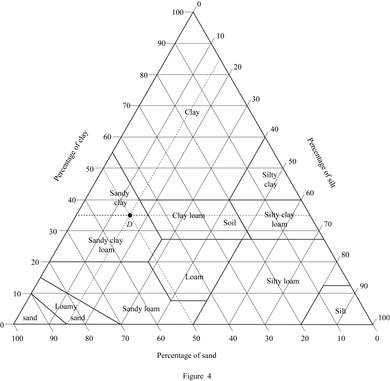
Refer Figure (4).
The classification of soil D as per the United States department of agriculture textural classification chart is
Consider soil E:
Mark the percentage of sand for soil E as 70 %, percentage of silt as 15 %, and percentage of clay as 15 % in Figure (5.1) and mark the point of intersection of three lines.
Show the percentage of sand, silt, and clay of soil E as in Figure (5).
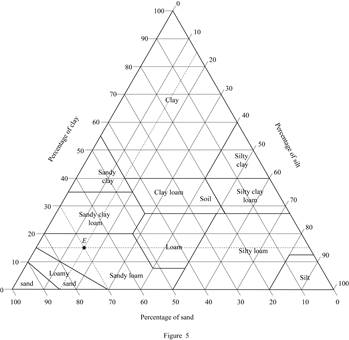
Refer Figure (5).
The classification of soil E as per the United States department of agriculture textural classification chart is
Consider soil F:
Refer Figure (5.1) “U.S. Department of agriculture textural classification (USDA)”
in the text book.
Mark the percentage of sand for soil F as 30 %, percentage of silt as 58 %, and percentage of clay as 12 % in Figure (5.1) and mark the point of intersection of three lines.
Show the percentage of sand, silt, and clay of soil F as in Figure (6).
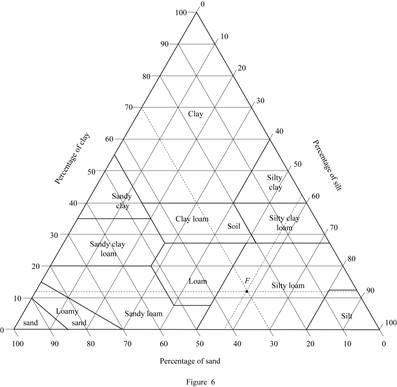
Refer Figure (6).
Hence, the classification of soil F as per the United States department of agriculture textural classification chart is
Consider soil G:
Mark the percentage of sand for soil G as 40 %, percentage of silt as 25 %, and percentage of clay as 35 % in Figure (5.1) and mark the point of intersection of three lines.
Show the percentage of sand, silt, and clay of soil G as in Figure (7).
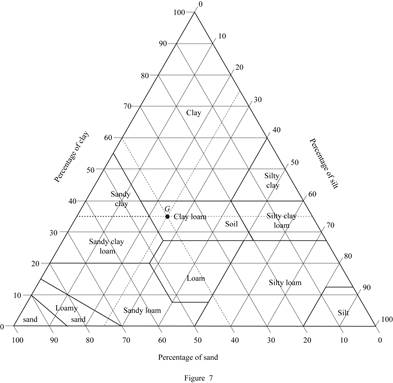
Refer Figure (7).
Thus, classification of soil G as per the United States department of agriculture textural classification chart is
Consider soil H:
Mark the percentage of sand for soil H as 30 %, percentage of silt as 25 %, and percentage of clay as 45 % in Figure (5.1) and mark the point of intersection of three lines.
Show the percentage of sand, silt, and clay of soil H as in Figure (8).

Refer Figure (8).
The classification of soil H as per the United States department of agriculture textural classification chart is
Consider soil I:
Mark the percentage of sand for soil I as 5 %, percentage of silt as 45 %, and percentage of clay as 50 % in Figure (5.1) and mark the point of intersection of three lines.
Show the percentage of sand, silt, and clay of soil I as in Figure (9).
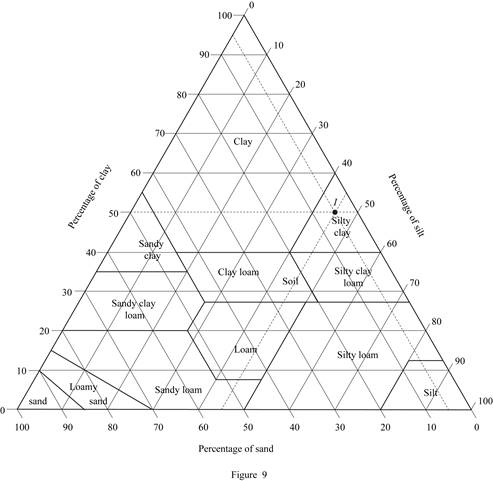
Refer Figure (9).
The classification of soil I as per the United States department of agriculture textural classification chart is
Consider soil J:
Mark the percentage of sand for soil J as 45 %, percentage of silt as 45 %, and percentage of clay as 10 % in Figure (5.1) and mark the point of intersection of three lines.
Show the percentage of sand, silt, and clay of soil J as in Figure (10).

Refer Figure (10).
The classification of soil J as per the United States department of agriculture textural classification chart is
Want to see more full solutions like this?
Chapter 5 Solutions
Principles of Geotechnical Engineering (MindTap Course List)
- For the beam show below, draw A.F.D, S.F.D, B.M.D A 2 N M 10 kN.m B 2 M Carrow_forwardB: Find the numerical solution for the 2D equation below and calculate the temperature values for each grid point shown in Fig. 2 (show all steps). (Do only one trail using following initial values and show the final matrix) T₂ 0 T3 0 I need a real solution, not artificial intelligence locarrow_forward: +0 العنوان use only Two rods fins) having same dimensions, one made orass (k = 85 Wm K) and the mer of copper (k = 375 W/m K), having of their ends inserted into a furna. At a section 10.5 cm a way from furnace, the temperature of brass rod 120 Find the distance at which the ame temperature would be reached in the per rod ? both ends are ex osed to the same environment. ns 2.05 ۲/۱ ostrararrow_forward
- I need a real solution, not artificial intelligencearrow_forwardI need detailed help solving this exercise from homework of Applied Mechanics. I do not really understand how to do, please do it step by step, not that long but clear. Thank you!arrow_forwardI need detailed help solving this exercise from homework of Applied Mechanics. I do not really understand how to do, please do it step by step, not that long but clear. Thank you!arrow_forward
- I need detailed help solving this exercise from homework of Applied Mechanics. I do not really understand how to do, please do it step by step, not that long but clear. Thank you!arrow_forwardI need detailed help solving this exercise from homework of Applied Mechanics. I do not really understand how to do, please do it step by step, not that long but clear. Thank you!arrow_forwardI need detailed help solving this exercise from homework of Applied Mechanics. I do not really understand how to do, please do it step by step, not that long but clear. Thank you!arrow_forward
- I need detailed help solving this exercise from homework of Applied Mechanics. I do not really understand how to do, please do it step by step, not that long but clear. Thank you!arrow_forwardI need detailed help solving this exercise from homework of Applied Mechanics. I do not really understand how to do, please do it step by step, not that long but clear. Thank you!arrow_forwardI need detailed help solving this exercise from homework of Applied Mechanics. I do not really understand how to do, please do it step by step, not that long but clear. Thank you!arrow_forward

 Structural Analysis (10th Edition)Civil EngineeringISBN:9780134610672Author:Russell C. HibbelerPublisher:PEARSON
Structural Analysis (10th Edition)Civil EngineeringISBN:9780134610672Author:Russell C. HibbelerPublisher:PEARSON Principles of Foundation Engineering (MindTap Cou...Civil EngineeringISBN:9781337705028Author:Braja M. Das, Nagaratnam SivakuganPublisher:Cengage Learning
Principles of Foundation Engineering (MindTap Cou...Civil EngineeringISBN:9781337705028Author:Braja M. Das, Nagaratnam SivakuganPublisher:Cengage Learning Fundamentals of Structural AnalysisCivil EngineeringISBN:9780073398006Author:Kenneth M. Leet Emeritus, Chia-Ming Uang, Joel LanningPublisher:McGraw-Hill Education
Fundamentals of Structural AnalysisCivil EngineeringISBN:9780073398006Author:Kenneth M. Leet Emeritus, Chia-Ming Uang, Joel LanningPublisher:McGraw-Hill Education
 Traffic and Highway EngineeringCivil EngineeringISBN:9781305156241Author:Garber, Nicholas J.Publisher:Cengage Learning
Traffic and Highway EngineeringCivil EngineeringISBN:9781305156241Author:Garber, Nicholas J.Publisher:Cengage Learning





